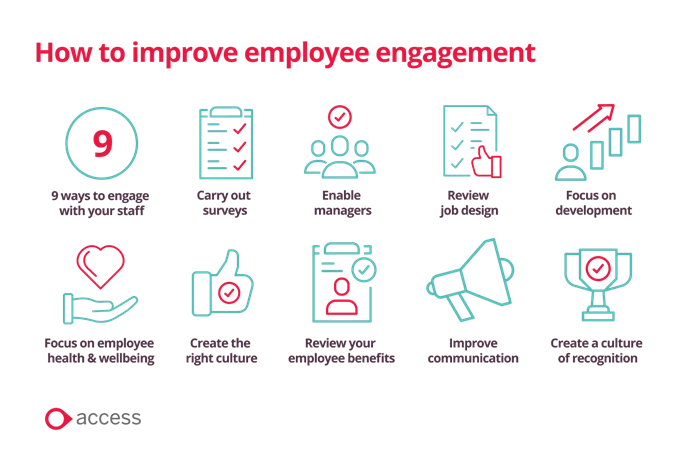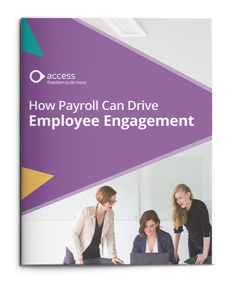How to improve employee engagement: A best practice guide
No matter how large or small your company, your employees are the driving force that keeps your business going and allows you to grow. Employees who feel happy and valued in their roles are more likely to perform well. Understanding how to improve employee engagement is therefore key to ensuring continued business success.
Employees who aren’t engaged may perform poorly or feel dissatisfied enough to leave their role, which can have a negative impact on productivity and profitability. In serious cases, dissatisfied employees may even create a negative or hostile environment, which can lead to further disengagement and other team members choosing to leave. If your business is facing any of these challenges, focusing on improving employee engagement could be just the boost you need to increase morale, boost productivity and support staff retention.
While the importance of employee engagement is well known, many businesses don’t have an active strategy in place to increase and maintain it. In this article, we’re going to explore employee engagement best practices, including top tips that your business can use to engage staff. From carrying out surveys to tracking job satisfaction using employee engagement software, there are lots of different ways to boost and maintain engagement. While not all of these solutions will be suitable for every business, the suggestions in this guide should help you to better understand the strategies you can take to keep your employees happy and loyal.
What is employee engagement?
Employee engagement is the emotional connection a person has to the organisation they work for. It’s fostered through a shared commitment to the company’s goals, a sense of belonging within the team, and suitable recognition for their contributions to the business.
This quote from author and inspirational speaker Simon Sinek sums it up well: "When people are financially invested, they want a return. When people are emotionally invested, they want to contribute."
Simply paying your employees isn’t enough to keep them engaged; this is really just the bare minimum requirement for fulfilling their employment contract.
Why is employee engagement important? How it affects businesses
A recent report by Gallup found that only 23% of employees globally are engaged, with the number dropping to 13% when looking at Europe. They have also found that a business with high engagement is 21% more profitable.
There have been numerous studies over the years that have linked engagement with business performance, suggesting that those who are more engaged in their roles are more likely to support business success. However, it’s worth noting that these statistics are correlative rather than causative, as successful workers are more likely to be rewarded for their efforts and feel engaged in their roles.
While this presents somewhat of a chicken-and-egg situation, the fact remains that there is a strong correlation between the two. It therefore makes sense that focusing on a strategy for improving employee engagement will in turn help to drive business growth and success.
What factors cause or hinder employee engagement? What the research says
When looking at ways to improve employee engagement, it’s important to first examine the different factors that contribute to it.
Some of the key elements to consider when looking at how to engage employees further and foster a positive working environment is how rewarding their role is. The CIPD refers to this as ‘good work’ and defines this as work that:
- is fairly rewarded
- gives people the means to securely make a living
- provides opportunities to develop skills and a career and gives a sense of fulfilment
- delivers a supportive environment with constructive relationships
- allows for work–life balance
- is physically and mentally healthy for people
- gives people the voice and choice they need to shape their working lives
- is accessible to all
To build on this, how organisations and their leaders work with and support employees has an important effect on keeping employees engaged. The 2009 MacLeod Review listed four key ‘enablers’ of engagement:
- Strong, strategic leadership that provides a narrative about the organisation
- Line managers who motivate, empower and support their employees
- Involving employees in decision making throughout the organisation
- Organisational values that are actually reflected in the workplace culture
By considering how well your organisation supports these factors, you can start to get a good picture of your current engagement levels, and which areas might need improvement.
How to improve employee engagement
There are many different ways to improve employee engagement, although not all of them may be suitable for your business. However, looking at the different strategies employers use to engage their staff can help to spark ideas for employee engagement strategies to implement in your own organisation.
1. Carry out surveys and get feedback
The first step is to find out what the current level of engagement is. This will give you a concrete starting point to measure improvements against, as well as offering deeper insights into the specific areas that need to be addressed. Surveys also give your employees a voice, allowing them to feel that their opinions are being considered, which can in itself contribute towards improvements.
When constructing your survey, focus on the factors affecting engagement that we’ve looked at above. Make sure your questions address how satisfied workers are with things like work-life balance, rewards and recognition, support from management and the nature of their work as a whole. It might take a few tries to get the structure of your survey right, but even basic multiple-choice questions can help to deliver actionable insights into how your employees are feeling.
2. Enable managers to improve employee engagement
As they represent a central point of communication between employees and business owners, it’s important to give managers the tools and support needed to encourage morale. They will be able to leverage everyday insights into both sides of the business, making them uniquely positioned to suggest ways to improve morale that are beneficial for both the business and the individual members of the team.
Great leaders and high-performing management are also factors that contribute, so providing training in leadership, communication and conflict resolution could be beneficial to create stronger, more productive teams. As well as improving the interpersonal relationships between employees and managers, this also helps to provide clear focus and direction for everyone.
3. Review job design
How much an employee enjoys their role is a key aspect in how engaged they feel. When creating roles and job descriptions, focus on making each one as fulfilling as possible, again taking into account the factors that affect engagement that we looked at above. For example, autonomy is often cited as a positive element in a job, allowing people to take ownership of their work and demonstrating a higher level of trust on the employer’s part.
To optimise job design, consider elements such as the demands of the role, the resources required, how stimulating the required tasks are, and how to measure and reward performance. Carrying out regular 1-2-1 meetings with employees, distributing surveys and collating feedback can help you to determine how well each role has been designed, and whether any changes are required.
4. Create a culture of recognition
While staff are of course obligated to complete their roles and responsibilities as part of their employment contract, thanking them for a job well done is a simple yet effective way to show appreciation. As highlighted in the CIPD 2023 Good Work Index, employees are less willing to go above and beyond for their employers, instead seeing their roles as a means to an end. To encourage employees to engage more, businesses need to reward them and recognise their efforts on a regular basis.
Implementing an employee rewards and recognition platform is a great way to support employee recognition. Particularly in today’s hybrid working environment, digital solutions are extremely beneficial for bringing team members together and allowing for fast, direct communication between managers and employees. From hosting awards and shout-outs to sharing peer-to-peer and manager-led recognition, these simple gestures can go a long way to improving morale.
5. Focus on career and personal development
When looking at how to increase employee engagement, it’s important to ensure that employees are supported in their personal and professional development. As well as giving them more opportunities to engage with their roles, continued training also helps them to provide further value for the business in the long term. Some organisations can be guilty of not providing additional training and development because they worry that employees will move on after developing new skills, making it a poor financial investment. However, employees often cite career development opportunities as one of the key factors that helps to boost engagement and encourage them to stay in a role for longer.
Providing funding and resources for training both hard and soft skills helps to ensure that employees are fully equipped to carry out their roles, and shows that you are invested in them. In turn, this helps to foster engagement and loyalty, as well as allowing the organisation to benefit from more skills and experience. Holding regular 1-2-1 meetings with employees presents a great opportunity to ask whether there are any areas in which they would like to upskill, again giving them a voice and showing that their needs are being met.
6. Make employee health and wellbeing a focus
Health and wellbeing are important parts of everyone’s lives, yet these are things that can be easily overlooked, particularly when a person is busy or stressed at work. Mind’s 2021/22 Work Wellbeing Index found that 77% of people have experienced poor mental health because of work. Because it’s such a large part of our daily lives, and because of the high rate of people citing work as a reason for poor mental health, employers should make it their responsibility to support mental health in the workplace to improve job satisfaction, morale and overall productivity.
Implementing an employee benefits platform can help to measure and improve both physical and mental wellbeing for workers, allowing them to access a wide range of tools, resources and rewards. By putting a focus on their health, you not only help to provide a better daily experience for them in the workplace, but also show a commitment to supporting them in the long term. This in turn helps to encourage employees to return this commitment, and puts them in a better mental and physical position to do so.
7. Review your employee benefits
Consider reviewing your employee benefits - they are a great way to show appreciation, but in order to really drive engagement, it’s important to make sure the perks on offer aren’t just a hollow gesture. Table football and free coffee may be nice, but they are inexpensive and ineffective when it comes to actually making a difference.
Instead, look at offering an employee assistance programme focused on supporting the mental and physical wellbeing of employees, as well as the often-overlooked financial wellbeing. Make sure to promote your employee benefits and provide education, as well as measuring their use so you can optimise your organisation’s programme to offer the support that’s actually needed.
8. Create the right culture
It’s important for businesses to define and emphasise a clear company culture, helping to create an environment that employees are proud to be a part of. From team-building events to supporting flexible working options, there are lots of ways to develop a workplace culture that is supportive and encourages employees to engage.
As revealed in the 2009 MacLeod Review, one of the key ‘enablers’ of engagement is values that are actually reflected in the organisation’s culture. It’s therefore important to back up your culture claims with real actions. A culture of trust sounds good on paper, but if employees are micromanaged in reality, this will cause friction between employees and management, leading to a lack of engagement.
9. Improve two-way communication
It’s important for managers to understand the importance of two-way communication with employees to encourage feedback and help make the organisation better for all. Ongoing communication is particularly difficult in hybrid working environments where team members don’t often interact in person, which is why digital solutions are so beneficial for the modern workplace.
Look for employee engagement software that includes internal social communication tools, providing a clear and consistent method of giving and receiving feedback, asking questions, and generally keeping in touch with other team members. Remember as well that it’s important to analyse and act upon suggestions that you receive to show that their input is valued, as well as to provide constructive, actionable feedback to help employees grow.
The Access Group recently hosted a customer roundtable in collaboration with HR Industry Analyst - Fosway Group. Fostering employee engagement was the main theme of the day with some interesting insights shared. Read our summary to find out more.
How to keep employees engaged
Once you’ve put in the hard work implementing employee engagement best practices, it’s important to monitor and maintain them. Here are some tips on how to keep employees engaged in the long term.
1. Recruit the right way
Maintain a culture of engagement by tailoring your recruitment process to focus on finding candidates who are the right fit for the environment. From writing job descriptions to carrying out the onboarding process, consider the important factors relating to engagement that we’ve looked at already. The more an employee feels a part of the team, the more likely they are to engage and foster deeper immersion throughout the wider business.
2. Carry out pulse surveys
Carrying out regular employee satisfaction surveys can help to measure engagement. The more regularly you gather feedback, the quicker you can spot patterns of a decrease in engagement, allowing for early intervention before it becomes a more serious problem for morale. Anonymous surveys will help to ensure that comments are open and honest, giving employees a safe space to voice any concerns and feel heard.
3. Continually review development and training
Make sure any funded training courses and qualifications are up to date and relevant to employee’s roles to provide the best value, both in terms of productivity and engagement. This is particularly important for fast-moving industries where tools and trends are constantly changing. Ask employees if there are any courses or workshops that they would like to undertake to boost their skills, and offer full or partial funding to show that you are invested in their continual development.
4. Regularly review your resources
Similarly, it’s important to regularly review hardware, software and other essential tech that allows your employees to do their jobs efficiently and to a high standard. Where roles or responsibilities have changed, make sure team members have appropriate access to the tools and data they need on a daily basis. Ergonomic office equipment is another element that can boost morale by supporting their physical wellbeing and productivity.
5. Introduce small gestures
Simple, thoughtful and impactful gestures can be a low-cost, high-reward method of keeping employees engaged. Peer-to-peer gift cards, performance-related bonuses, and non-monetary rewards such as email shout-outs for a job well done or an early finish after the completion of a large project can mean a lot to employees.
4 employee engagement best practices
The best way to ensure ongoing engagement in your organisation is to foster a culture of engagement that is embedded in the way your business operates on a daily basis. Let’s take a look at 4 employee engagement best practices that will help your business to ensure long-term success instead of a fleeting boost in satisfaction.
1. Measure employee engagement levels accurately, effectively and consistently
To manage, monitor and improve employee engagement levels, you need to make sure you’re accurately measuring how engaged members of staff are on a regular basis. Use employee engagement software to track results of surveys and ensure that all data and analytics are readily available to key stakeholders within the organisation.
2. Lead from the top down
Building any form of culture in the workplace comes from the top, so it’s best to practice what you preach at all times. Encourage managers and team leaders to uphold the key principles that have been shown to support morale, and ensure that regular training and catch-up meetings to make sure their own values are aligned with those of the overall organisation.
3. Be empathetic and understand employee needs
Empathy is important when looking at ways to improve morale. While employees are there to do a job, they are real human people with their own lives, goals and emotions. A message that doesn’t resonate won’t get through, so find out what motivates each individual and employ a tailored approach to boost engagement.
4. Maintain transparency
Honesty and transparency within the company and its leadership are key to building trust among employees. No matter how closely you follow these employee engagement best practices, your efforts won’t amount to anything without mutual trust. This is the secret to ensuring that employees feel able to fully collaborate and participate on a deep and meaningful level rather than simply cashing a paycheque.
To see real-world examples of how companies have successfully built trust and engaged their employees, check out our guide on EVP examples.
Improving employee engagement
In this article, we’ve seen that employee engagement is extremely important to improve and maintain job satisfaction and productivity in the workplace. From working to create a positive atmosphere where employees have the tools, support and training they need to perform their roles to ensuring that employees are suitably rewarded for their efforts, there are many different methods to engage staff on a meaningful level.
The most important thing to consider when looking at how to increase employee engagement is creating an overall culture of honesty and support within your daily business operations. The more deeply embedded these practices are, the easier it will be to maintain long-term engagement in the workplace.
Contact us to find out more about our employee engagement software solutions
Latest employee benefits resources
Our employee benefits resources offer advice and guidance from industry experts on a range of topics, drawing on our years of experience and expertise in employee benefits.

 AU & NZ
AU & NZ
 SG
SG
 MY
MY
 US
US
 IE
IE









